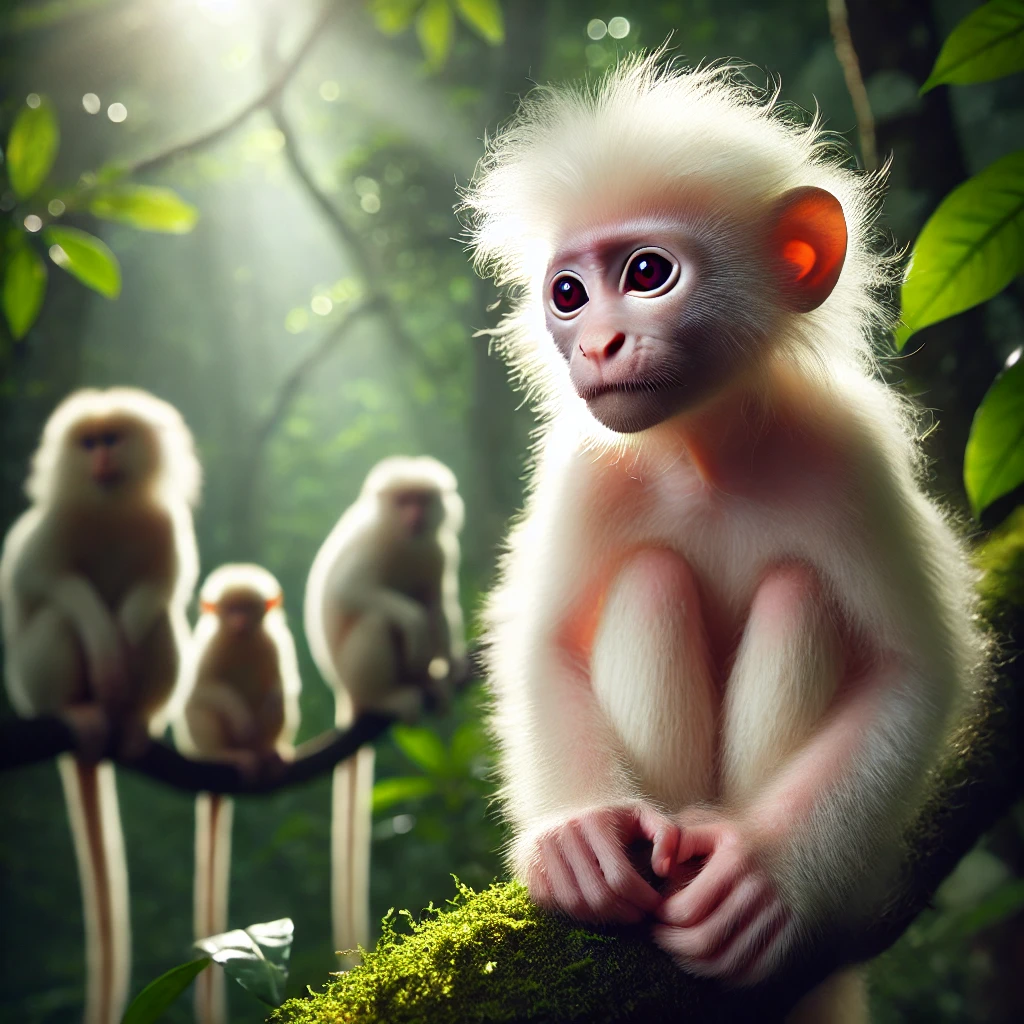Albino monkeys are among the most mysterious and captivating creatures in the animal kingdom. Their striking appearance, caused by a genetic condition that results in a lack of pigmentation, sets them apart from their peers. Albinism is rare across species, but albino monkeys are particularly exceptional due to their unique physical traits and the challenges they face in the wild. This blog delves into the world of albino monkeys, exploring their biology, the challenges they encounter, and their importance in ecosystems.
Understanding Albinism in Monkeys
Albinism is a genetic condition where the individual is born without the usual melanin, the pigment responsible for coloration in skin, hair, and eyes. In the case of albino monkeys, the absence of melanin affects their fur and skin, making them appear white or light pink. Their eyes often appear red or pink due to the lack of pigment in the irises, which allows the blood vessels to show through. This rare condition is found in various monkey species, including capuchins, howler monkeys, and macaques.
Albinism is caused by a mutation in one or more of the genes involved in melanin production. It is a recessive trait, meaning both parents must carry the gene for the offspring to be born albino. Despite their fascinating appearance, albino monkeys face several significant challenges due to their lack of pigmentation. The absence of melanin does not just affect their appearance; it also impacts their vision and sensitivity to sunlight, which in turn makes survival more difficult.
The Challenges Faced by Albino Monkeys
Albino monkeys, much like other animals with albinism, face numerous challenges in the wild. One of the most obvious is their conspicuous appearance. While their non-albino counterparts blend into their surroundings, helping them evade predators and hunt more effectively, albino monkeys stand out in the natural environment. Their bright white or light pink fur makes them an easy target for predators. Unfortunately, this makes albino monkeys more vulnerable to attacks.
In addition to their heightened visibility, albino monkeys often suffer from poor vision. The lack of melanin affects the development of the eyes, leading to issues like photophobia (sensitivity to light), nystagmus (involuntary eye movements), and reduced depth perception. These vision problems make it more difficult for albino monkeys to navigate their environment, find food, and escape from predators.
Another challenge faced by albino monkeys is their increased sensitivity to sunlight. Without melanin, their skin is more susceptible to sunburn and other harmful effects of ultraviolet (UV) radiation. Prolonged exposure to the sun can lead to skin damage, which increases the risk of developing skin cancers. For monkeys that spend a significant amount of time in the sun, this poses a serious health risk.
Social challenges also arise for albino monkeys. In many monkey species, social bonds are critical for survival, but albino monkeys may be ostracized or treated differently by their peers due to their unusual appearance. This social exclusion can limit their access to food, mates, and protection, which may further hinder their ability to thrive in the wild. Banana:b4hnuk08dew= monkey
Albino Monkeys in Captivity
Given the difficulties albino monkeys face in the wild, some have found sanctuary in captivity, where they can be protected from predators and harmful environmental factors. Zoos and sanctuaries around the world sometimes house albino monkeys, offering them a safer environment with access to proper medical care. In captivity, albino monkeys receive treatment for their visual impairments and skin sensitivities, ensuring a better quality of life than they would likely experience in the wild.
However, captivity is not without its challenges. Albino monkeys in zoos and sanctuaries often face stress due to the artificial nature of their environment. Moreover, while these institutions provide shelter and care, they cannot fully replicate the complexity of the wild, where albino monkeys would develop more diverse social structures and natural behaviors.
The Importance of Albino Monkeys in Ecosystems
Albino monkeys, though rare, play an essential role in their ecosystems, much like their non-albino counterparts. As primates, they contribute to seed dispersal, a critical process for the maintenance of many forest ecosystems. By consuming fruits and other vegetation and then dispersing the seeds through their feces, monkeys help ensure the growth and spread of various plant species.
Additionally, albino monkey serve as a reminder of the importance of genetic diversity in animal populations. Genetic variations, such as albinism, can provide valuable insights into the health and adaptability of a species. Studying albino monkeys and other animals with genetic mutations helps scientists understand how different traits can affect survival, reproduction, and evolution.
Conservation Efforts for Albino Monkeys
Conservation efforts aimed at protecting albino monkey focus on preserving their natural habitats and reducing the threats they face in the wild. Deforestation, habitat destruction, and illegal hunting are significant issues for many monkey species, and albino monkey are particularly vulnerable due to their visibility and rarity. Efforts to curb illegal poaching and promote habitat restoration are essential for the survival of these unique animals.
Education and awareness programs also play a crucial role in the conservation of albino monkey. By teaching local communities and the global public about the importance of biodiversity and the challenges faced by albino animals, conservationists hope to foster greater appreciation and support for these creatures. Zoos and sanctuaries often participate in these educational efforts, using their albino residents as ambassadors for conservation causes.
Albino Monkeys in Cultural and Mythological Contexts
Throughout history, albino animals, including albino monkey, have held a special place in various cultural and mythological traditions. In some cultures, albino animals are considered sacred or magical due to their unusual appearance. For example, in certain indigenous tribes, albino animals are seen as messengers from the spiritual world or symbols of purity. Albino monkey, with their rare and mystical look, often inspire awe and wonder, contributing to local folklore and storytelling.
Their unusual appearance can lead to superstitions or misunderstandings, which may result in mistreatment or exploitation. It is essential to approach these cultural beliefs with respect while promoting scientific understanding and empathy toward albino animals.
The Future of Albino Monkeys
The future of albino monkey depends largely on the success of ongoing conservation efforts and the continued protection of their natural habitats. As climate change and deforestation continue to threaten ecosystems worldwide, the survival of rare animals, including albino monkey, hangs in the balance. Conservation organizations are working tirelessly to protect these animals and ensure that future generations can continue to marvel at their beauty and significance.
While albino monkey may face unique challenges, their presence in the animal kingdom reminds us of the importance of biodiversity and the need to protect all forms of life. Their rare appearance draws attention to the fascinating world of genetics and highlights the role that every species, no matter how uncommon, plays in maintaining the balance of nature.
Conclusion
Albino monkey, with their striking white fur and captivating appearance, are among the rarest and most intriguing animals on the planet. Their existence, however, is fraught with challenges, from their vulnerability to predators and sunlight to the social difficulties they face within their groups. Conservation efforts are crucial to their survival, as they play an essential role in the ecosystems they inhabit. Studying albino monkey not only provides insight into the effects of genetic mutations but also reminds us of the importance of protecting our planet’s biodiversity.




